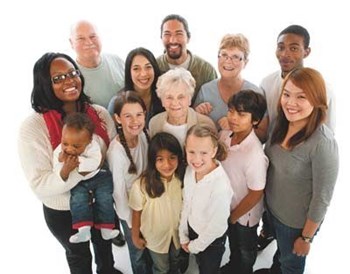
Two important shifts in U.S. demographics are playing a role in planning the future of condominium communities. First, the nation’s population, including that of New England, is becoming more racially and ethnically diverse. Second, people are living longer, and many of those individuals plan to stay in their homes as long as possible.
While condo association boards and management teams already have plenty on their minds, they may find it useful to think strategically about the future satisfaction of a broader array of residents. Actions and policies that support cultural, racial, and age diversity better position the association to communicate with and retain homeowners.
From ‘Minority’ to ‘Majority’
Over the next 20 years, the complexion of U.S. cities and counties is expected to change, in some cases dramatically. Today, four states (Hawaii, New Mexico, California, and Texas) have already seen their minority populations exceed 50 percent (no longer a “minority”) according to U.S. Census data. New England states such as Massachusetts have seen their minority populations increase, a trend that is likely to continue because of falling birthrates among whites, according to Census-data analysts.
In Massachusetts, out of a population of 6,593,587, whites make up 85.9 percent, Latinos 8.8 percent, blacks 7.1 percent, and those who describe themselves as foreign-born 12.2 percent, according to Census data. The data also shows that 18.7 percent of Massachusetts’ residents reported speaking a language other than English at home.
In bigger Massachusetts cities, such as Boston, Worcester, and Springfield, the increase in the number of Latinos and Asians over the past decade has been particularly marked. While the economic downturn disproportionately affected homeownership among minorities in poorer communities, according to David J. Levy of Sterling Services in Holliston, Massachusetts, evidence suggests that, in affluent communities, homeownership by Southeast Asian and other Asian groups has held steady or increased.
Longer Life Spans
The National Aging in Place Council, interpreting census data, says that by the year 2030, 20 percent of all U.S. residents will be over age 65. “At that time, 32 states will have populations that look like Florida today,” the NAIPC says on its website. And experts are predicting that the number of very old residents (beyond age 85) will hit 30 million in 2050, with 2.5 million people living to be older than 100.
What do these demographic changes mean for condominium complexes? A more racially and ethnically diverse constituency may require changes in how management communicates the rules, treats issues such as noise, and trains its staff members in cultural sensitivity. An aging population requires certain services that may include building ramps, installing grab bars in bathrooms, and re-carpeting areas that serve wheelchairs.
But more than just creating a safer, more welcoming environment for minority or older residents, board members and management company employees will want to examine their own attitudes and assumptions.
Avoiding labels
“Condos are a reflection of our social picture,” says Jasmine Martirossian, a board strategist whose doctoral dissertation focused on group dynamics and board governance issues. “Stereotypes are a shorthand way for our brain to categorize things quickly,” she says. “We tend to pigeonhole the elderly and ethnic groups. But when labels are created things deteriorate from there.”
Martirossian describes a social science experiment in which employers and job candidates actually overlooked racial characteristics to align themselves with people who agreed with them, rather than with people who disagreed but were of the same ethnicity. “Thinking the same” is a powerful connector, Martirossian says, but people have to talk with one another to get to that point of common ground.
“Conflicts arise when people don’t know what they are expected to do,” says Martirossian. “It’s already a problem that English-speaking residents don’t read the condo rules. Imagine if you don’t read English at all.”
In higher-end condo complexes, residents usually hold professional jobs and already are fluent in English. But at the lower end, residents are often struggling to hold down several jobs to make ends meet, and they may lack reading and writing skills in their own language.
The decision about whether to put up signs or send out notices in multiple languages can be fraught with controversy. In one camp are people who say immigrants should learn English, and in the other are those who want rules and bylaws to be clearly understood. The extra work and cost involved in multilingual signage and in translating notices is probably prohibitive for any complex except one with very high numbers of non-English speakers, says Martirossian.
A better way to reach those who don’t speak English is to involve their children or grandchildren, who usually do speak English, Martirossian says. Creating a neighborly environment through people “breaking bread together” also reaps dividends in cooperation and cross-cultural communication. Encouraging a variety of people to volunteer for committees and on the board also will help carry other viewpoints to decision makers.
Levy’s management company, Sterling Services, has several staff members, including one portfolio manager, who speak Spanish and Portuguese. They help serve the 95 percent of his residents who moved to Metrowest Boston from Brazil and other Latin American countries. Sterling Services also sponsors summer socials in which Latin foods share a table with hamburgers and hot dogs. Not only do residents appreciate the effort at making them feel comfortable, Levy says, but also these moves have given his company an edge on a practical and marketing level.
Unfortunately, culture can also be used as an excuse for not following rules. Levy tells of a situation in which a few individuals hanging out on a doorstep were playing music loudly enough to disturb other residents. When they were reminded of the noise rules, they argued that the music was part of their culture and that the rule was unfair. The tenants were encouraged to attend the regularly scheduled meetings on rules and rule enforcement, so their views could be aired.
“When people feel something is being forced on them, they reject it,” Martirossian says.
Aging in Place
Any discussion of race and ethnicity brings up powerful emotional responses. But aging, and the need to plan for an aging population, is a topic that sneaks up on people. “It still comes as a surprise,” Martirossian says. Americans tend to compartmentalize and institutionalize the elderly, while people in other countries shake their heads and say, “Why would you want to leave your home when you’re old?” she says.
American attitudes, led by the baby boomers, have already started to change. In an AARP poll conducted in November 2010, nearly 75 percent of the respondents (age 45 and older) said they hoped to stay in their homes as they age.
As more residents choose to “age in place”—rather than moving into retirement communities or assisted livin — changes will likely be needed to help keep them safe.
But there’s no getting around the fact that seniors experience a greater number of health problems. The NAIPC reports that more than two-thirds of all older people who need help with everyday tasks live at home, including more than 70 percent of those with Alzheimer’s disease. Chronic health conditions such as diabetes and arthritis, events such as falls or strokes, along with medications used to treat other ailments, can greatly affect mobility, the NAIPC says.
The most important step, say experts, is to reduce the risk of falling inside and outside the home. Falls can lead to a host of other difficulties that affect seniors’ ability to remain in their homes. Stairs, steps, and entryways bear special attention.
Universal Design
Fortunately, improvements such as ramps and wider doorways can improve life for other residents as well. These amenities address a spectrum of mobility needs: older residents with walkers, people in wheelchairs, parents with strollers, residents with shopping carts, and even delivery people and moving companies. A condo complex that complies with ADA (Americans with Disabilities Act) regulations is already providing accessibility for its seniors. This notion of infrastructure that works for people of all ages and stages of life is called Universal Design.
Retrofitting New England’s older housing stock along the lines of Universal Design, or ADA compliance, is an expensive proposition.
Still, small changes applied gradually can help condo associations make headway. For example, when carpet needs replacing, choosing a low-pile option can make it easier for people with walkers and wheelchairs to navigate, says Amy Levner, manager of education and outreach for the AARP. She also urges condo complexes to consider redundant safety features. For people with hearing issues, having a phone or fire alarm that flashes as well as rings could be vital.
She suggests that communities provide a space for seniors to meet and form a network that can serve both social and practical needs. One example of such a network is the Beacon Hill Village in Boston, whose members banded together to offer cooperative services such as garden maintenance, house cleaning, meal delivery, transportation to doctors’ appointments, and pet sitting. The Village concept has gathered steam and spread to other cities.
“We have to reduce the ‘us-vs.-them’ mentality,” says Levy, “whether it’s in the context of race or the context of age.”
By discovering the humanity in others, sharing a pizza or coffee, getting to know them “instead of delving into ‘otherness,’” says Martirossian, “we create a situation conducive to neighborliness and goodwill.”
April Austin is a freelance writer and a frequent contributor to New England Condominium.




Leave a Comment